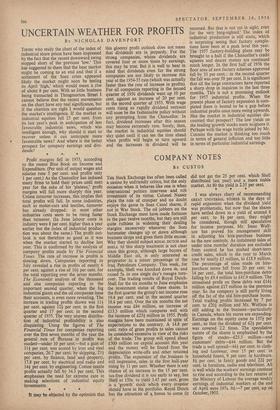UNCERTAIN WEATHER FOR PROFITS
BY NICHOLAS DAVENPORT THOSE who study the chart of the index of industrial share prices have been impressed by the fact that the recent downward swing stopped short of the previous low.' This has suggested to them that the bear market might be coming to an end and that if a settlement of the Suez crisis appeared likely the market might soon be testing its April 'high,' which would mean a rise of about 8 per cent. With so little business being transacted in Throgmorton Street I cannot believe that the recent movements on the chart have any real significance, but if the chartists are right I would question the market's intelligence. If the market in industrial equities fell 25 per cent. from its last year's peak in anticipation of less favourable industrial news, which was intelligent enough, why should it start to recover unless it can anticipate more favourable news? And where is the better prospect for company earnings and divi- dends?
Profit margins fell in 1955, according to the recent Blue Book on Income and Expenditure. (Per unit of output wages and salaries rose 5 per cent. and profits only 1 per cent.) As the Chancellor has induced many firms to hold their prices until next year for the sake of his 'plateau,' profit margins will fall more sharply this year. Unless turnover increases, this implies that total profits will fall. In some industries, such as motor-cars and textiles, turnover has already dropped : in most other industries costs seem to be rising faster than turnover. (In June labour costs in industry were 8 per cent. higher than a year earlier but the index of industrial produc- tion was about the same.) The profit out- look is not therefore so good as it was when the market started to decline last year. This is confirmed by the analysis of company profits made by The Financial Times. The rate of increase in profits is slowing down. Companies reporting in July revealed a rise in profits of nearly 6 per cent. against a rise of 104 per cent. for the total reporting over the seven months. The Economist analysis of the thousand and one companies reporting in the important second quarter, when the big industrial giants and the oil companies issue their accounts, is even more revealing. The increase in trading profits shown was 11/ per cent. against 124 per cent. in the first quarter and 17 per cent. in the second quarter of 1955. The very uneven distribu- tion of industrial profitability is also disquieting. Using the figures of The Financial Times for companies reporting over the first seven months of the year the general rate of increase in profits was modest—under 10 per cent.—but a gain of 311 per cent. was scored by iron and steel companies, 26.7 per cent. by shipping, 214 per cent. by finance, land and property, 17.8 per cent. by electrical and radio and 144 per cent. by engineering. Cotton textile profits actually fell by 34.3 per cent. This emphasises the need for extreme care in making selections of industrial equity investments.
• • • It may be objected by the optimists that this gloomy profit outlook does not mean that dividends are in jeopardy. For the strong companies, whose dividends are covered four or more times by earnings, this may be true. But it is well to bear in mind that dividends even for the strong companies are not likely to increase this year at the 1954-55 rate (which was actually faster than the rate of increase in profits). For all companies reporting in the second quarter of 1956 dividends went up 10 per cent. against an increase of 20 per cent. in the second quarter of 1955. With wage costs rising so rapidly dividend restraint will soon be the fashionable policy without any prompting from the Chancellor. In fact, dividend increases after this season may become extremely rare. Surely, then, the market in industrial equities should stay quiet until it can see the time ahead when profits Will begin to turn upward and the increases in dividend will be resumed. But that is not yet in sight, even for the very long-sighted.' The index of industrial production is still static, which is surprising seeing that factory comple- tions have been at a peak level this year. The 1957 factory-building plans may be brought to a halt if the Chancellor's credit squeeze and dearer money are continued much longer. In the first half of 1956 the floor area of new factory schemes approved fell by 33 per cent. : in the second quarter the fall was over 50 per cent. It is significant that all the large contractors have reported a sharp drop in inquiries in the last three months. This is not a promising outlook for 1957 industrial profits. When the present phase of factory expansion is com- pleted there is bound to be a gap before industrial profits once more swing upwards. Has the market in industrial equities dis- counted that prospect? The low yields on the leading 'growth' stocks seem to ignore it. Perhaps with the wage battle joined by Mr. Cousins the market is thinking too much in terms of general inflation and too little in terms of particular industrial earnings.


































 Previous page
Previous page